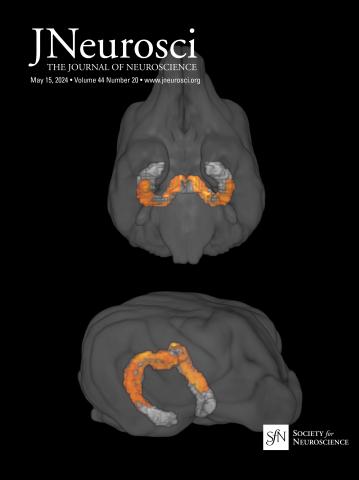HDAC3丝氨酸424磷酸化模拟和磷酸化缺失突变体双向调节成年和衰老小鼠大脑的长期记忆形成和突触可塑性。
IF 4
2区 医学
Q1 NEUROSCIENCES
引用次数: 0
摘要
长期记忆的形成受到组蛋白去乙酰化酶3 (HDAC3)的负调控,这是一种转录抑制因子。新出现的证据表明,HDAC3在其丝氨酸424 (S424)残基上的翻译后磷酸化对其转录中的去乙酰化酶活性至关重要。然而,HDAC3 S424磷酸化是否调节HDAC3调节长期记忆形成的能力仍不清楚。为了检验S424的功能,我们在小鼠海马背侧表达了HDAC3-S424D磷酸化模拟突变体(组成活性形式)或HDAC3-S424A磷酸化无突变体(去乙酰化酶死亡形式)。我们评估了这些突变对年轻成年雄性小鼠长期记忆(LTM)形成和长期增强(LTP)的功能后果。我们还评估了HDAC3-S424A突变体是否可以改善衰老雄性和雌性小鼠LTM和LTP的年龄相关缺陷。结果表明,在海马背侧表达HDAC3-S424D磷酸化模拟突变体的年轻成年雄性小鼠表现出明显的LTM和LTP损伤。相比之下,在年轻成年雄性小鼠海马中表达的HDAC3-S424A磷酸化零突变体使阈下学习转化为稳健的LTM和增强的LTP。同样,HDAC3-S424A突变体的表达使衰老的雄性和雌性小鼠的LTM形成和LTP增强。总之,这些发现表明HDAC3 S424是一个关键残基,在成人和衰老大脑中具有双向调节突触可塑性和LTM形成的能力。组蛋白去乙酰化酶3 (HDAC3)是突触可塑性和记忆的负调节因子。然而,调控HDAC3活性的机制仍然知之甚少。这项研究证明了HDAC3的丝氨酸424在双向调节长时程增强(一种突触可塑性形式)和长时程记忆形成方面的关键性质。丝氨酸424是一个磷酸化位点,提示HDAC3的磷酸化是其调控长时记忆所需基因表达的关键调控机制。事实上,衰老大脑中丝氨酸424磷酸化缺失的表达改善了衰老雄性和雌性小鼠的年龄依赖性长期突触可塑性和长期记忆缺陷。因此,本研究为认知过程中HDAC3活性的调控提供了新的见解。本文章由计算机程序翻译,如有差异,请以英文原文为准。
HDAC3 Serine 424 phospho-mimic and phospho-null mutants bidirectionally modulate long-term memory formation and synaptic plasticity in the adult and aging mouse brain.
Long-term memory formation is negatively regulated by histone deacetylase 3 (HDAC3), a transcriptional repressor. Emerging evidence suggests that post-translational phosphorylation of HDAC3 at its serine 424 (S424) residue is critical for its deacetylase activity in transcription. However, it remains unknown if HDAC3 S424 phosphorylation regulates the ability of HDAC3 to modulate long-term memory formation. To examine the functionality of S424, we expressed an HDAC3-S424D phospho-mimic mutant (constitutively active form) or an HDAC3-S424A phospho-null mutant (deacetylase dead form) in the dorsal hippocampus of mice. We assessed the functional consequence of these mutants on long-term memory (LTM) formation and long-term potentiation (LTP) in young adult male mice. We also assessed whether the HDAC3-S424A mutant could ameliorate age-related deficits in LTM and LTP in aging male and female mice. Results demonstrate that young adult male mice expressing the HDAC3-S424D phospho-mimic mutant in dorsal hippocampus exhibit significantly impaired LTM and LTP. In contrast, the HDAC3-S424A phospho-null mutant expressed in the hippocampus of young adult male mice enabled the transformation of subthreshold learning into robust LTM and enhanced LTP. Similarly, expression of the HDAC3-S424A mutant enabled LTM formation and enhanced LTP in aging male and aging female mice. Overall, these findings demonstrate that HDAC3 S424 is a pivotal residue that has the ability to bidirectionally regulate synaptic plasticity and LTM formation in the adult and aging brain.Significance statement Histone deacetylase 3 (HDAC3) is a negative regulator of synaptic plasticity and memory. However, the mechanism that regulates HDAC3 activity remains poorly understood. This study demonstrates the pivotal nature of Serine 424 of HDAC3 to bidirectionally regulate long-term potentiation, a form of synaptic plasticity, and long-term memory formation. Serine 424 is a phosphorylation site, suggesting that phosphorylation of HDAC3 is a key regulatory mechanism controlling its regulation of gene expression required for long-term memory. Indeed, expression of a Serine 424 phospho-null in the aging brain ameliorated age-dependent long-term synaptic plasticity and long-term memory deficits in aging male and aging female mice. Thus, this study provides new insight into the regulation of HDAC3 activity involved in cognitive processes.
求助全文
通过发布文献求助,成功后即可免费获取论文全文。
去求助
来源期刊

Journal of Neuroscience
医学-神经科学
CiteScore
9.30
自引率
3.80%
发文量
1164
审稿时长
12 months
期刊介绍:
JNeurosci (ISSN 0270-6474) is an official journal of the Society for Neuroscience. It is published weekly by the Society, fifty weeks a year, one volume a year. JNeurosci publishes papers on a broad range of topics of general interest to those working on the nervous system. Authors now have an Open Choice option for their published articles
 求助内容:
求助内容: 应助结果提醒方式:
应助结果提醒方式:


